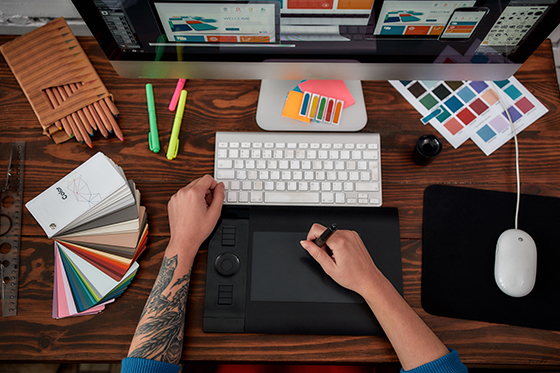
October 7, 2025
Polished, clean visuals are vital to a successful marketing campaign. When starting a creative project, there are a few key principles to be aware of to ensure the process runs smoothly. Whether you’re a design expert or novice, here are some basics to keep in mind for your next project!
CMYK vs RGB: What’s the Difference?
First, it’s important to understand the difference between CMYK and RGB color modes. The technical differences stem from how colors are mixed, but the main thing to note is that the color mode used depends on the medium of the finished product.
CMYK stands for Cyan, Magenta, Yellow, and Black (K). CMYK is primarily used for printed designs like brochures.
A few other examples that require files in CMYK color mode:
Resolution
Resolution refers to the level of detail and quality of the image, measured by dots per inch (DPI) for print formats and PPI (pixels per inch) for digital. For print, the recommended minimum resolution is 300 DPI. 72 PPI is the recommended minimum resolution for digital projects. This includes any images or graphics used in the project.
Generally, the higher the resolution, the more detailed the final image will be. Checking the resolution is as easy as viewing the file on your computer. On Windows, right-click on the image, select Properties, then click Details. On a Mac, open the image with Preview, select Tools, then Adjust Size.
File Types
There are many different types of files, and each one has a different use case. For logo files, vector format is preferred, which includes EPS files for print projects and SVG for digital ones. Vectors provide the highest graphic quality and allow for scalability in layout. When sharing images, a JPG will work in most cases, or a PNG for digital graphics with transparency. Other common file types include a GIF, primarily used for animated digital images, and a PDF, used for print documents. Most projects will require a mix of different file types to create the final visual. Take a print ad for example. There may be a JPG image featured in the header area, as well as an EPS for the logo in the footer. Sharing the appropriate kind of file allows designers to create an effective design.
Whatever your final deliverable may be, with the correct color mode, resolution, and file types, your design team will have all the necessary tools to create an eye-catching design that showcases your brand and products as effectively as possible.
First, it’s important to understand the difference between CMYK and RGB color modes. The technical differences stem from how colors are mixed, but the main thing to note is that the color mode used depends on the medium of the finished product.
CMYK stands for Cyan, Magenta, Yellow, and Black (K). CMYK is primarily used for printed designs like brochures.
A few other examples that require files in CMYK color mode:
- Flyers
- Posters
- Print Ads
- Business Cards
- Booklets
- Signs
- Websites
- Landing Pages
- Social Media Graphics
- Social Newsfeed Ads
- Story Ads
- Videos
Resolution
Resolution refers to the level of detail and quality of the image, measured by dots per inch (DPI) for print formats and PPI (pixels per inch) for digital. For print, the recommended minimum resolution is 300 DPI. 72 PPI is the recommended minimum resolution for digital projects. This includes any images or graphics used in the project.
Generally, the higher the resolution, the more detailed the final image will be. Checking the resolution is as easy as viewing the file on your computer. On Windows, right-click on the image, select Properties, then click Details. On a Mac, open the image with Preview, select Tools, then Adjust Size.
File Types
There are many different types of files, and each one has a different use case. For logo files, vector format is preferred, which includes EPS files for print projects and SVG for digital ones. Vectors provide the highest graphic quality and allow for scalability in layout. When sharing images, a JPG will work in most cases, or a PNG for digital graphics with transparency. Other common file types include a GIF, primarily used for animated digital images, and a PDF, used for print documents. Most projects will require a mix of different file types to create the final visual. Take a print ad for example. There may be a JPG image featured in the header area, as well as an EPS for the logo in the footer. Sharing the appropriate kind of file allows designers to create an effective design.
Whatever your final deliverable may be, with the correct color mode, resolution, and file types, your design team will have all the necessary tools to create an eye-catching design that showcases your brand and products as effectively as possible.






